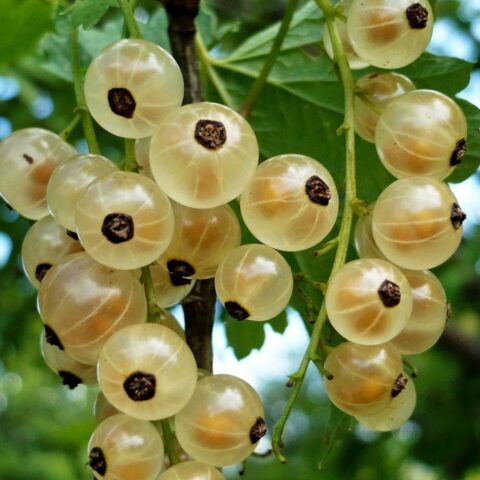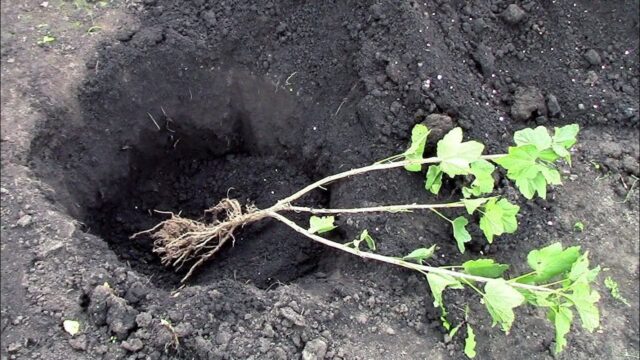Content
White Fairy currant is a productive variety that produces more than 5 kg per bush. The berries are one-dimensional, small in size, with a pleasant delicate taste. The bushes are compact and do not take up much space. They grow well in the climatic conditions of the middle zone.
History of selection
White Fairy (also called Diamond) is a Russian variety of white currant, obtained by breeders V.M. Litvinova. and Smolyaninova N.K. on the basis of the Federal Scientific Center for Horticulture. During development, the researchers conducted open pollination of different cultivars. The application for admission was submitted back in 1991.
After passing successful tests, the variety was included in the register of breeding achievements in 2007. Approved for cultivation in Central Russia, including the Moscow region and neighboring regions.
Description of the White Fairy currant variety
The description of the currant variety provides the main characteristics of the bush, size, shape, color of the berries. The main parameters are presented in the following sections.
Bush
The White Fairy currant bushes are of medium vigor, the crown is compact, and practically does not spread out to the sides. Shoots without lignification, moderate thickness, green color. The color may also have a brownish-red tint. There is no pubescence on the surface, the branches are straight, without bending. As they mature, they become covered with wood, become thicker, and the color changes to gray-brown.
Currant buds of the White Fairy variety are arranged singly, the stems are short. They are quite large, have an ovoid, blunt shape, and a gray-brown color. There is no pubescence, they deviate slightly from the shoots. In this case, the apical buds are not free.
The leaves of the White Fairy currant have a 3- or 5-lobed shape, they are small in size, the surface is dense, matte, and has no pubescence. The color is green, rich. Along the central vein, the plates are bent inward. In this case, the edges rise slightly. The middle blades are sharp and longer than the lateral ones.

The bush produces tasty medium-sized berries
The basal lobes are poorly developed. The edges of the leaf blades of the White Fairy currant have teeth; they are blunt, medium in size, and do not have pronounced “tips.” There is a core at the base, a shallow notch. The petioles are quite long, medium thickness, green in color, with a noticeable pinkish tint.
White Fairy currant flowers are small, saucer-shaped, with a green ridge near the pistil. The sepals are yellowish-greenish in color interspersed with pink streaks. The brushes are medium in size, from 8 to 9 cm including petioles, medium density. The axes are of medium thickness, there is no pubescence, the petioles are short. The stalks are also small, thin, green. They have no pubescence.
Berries
The fruits of the White Fairy currant are small, weighing on average 0.6 g, individual specimens up to 0.8. They are one-dimensional, round in shape, white in color, with noticeable stripes. The detachment from the stalks is dry, which makes harvesting easier. Each berry has seeds, they are small. The calyxes are medium-sized, closed, and do not fall off even after ripening.
Characteristics of the variety
Among the main characteristics of the variety, summer residents are interested in the taste of the berries, ripening time, and yield indicator. The most important parameters are described below.
Taste qualities
White Fairy currant berries have a sweet and sour taste, quite delicate and pleasant. At the tasting assessment we received 4.0 points out of a maximum of 5. The composition contains sugars (mass fraction 6.8%), acids (up to 2.2%), including vitamin C - almost 42 mg per 100 g. Taste is good , but there is practically no aroma.
Ripening time
According to the ripening period, the White Fairy currant belongs to the mid-season varieties. The fruits form in July and begin to ripen in early August.
Productivity
One of the advantages of the White Fairy currant variety is its very high yield. If the rules of care are followed, up to 5.2 kg of tasty berries can be collected from one adult bush. If grown in large areas, you can harvest up to 13.4 t/ha.
Frost resistance of currants White Fairy
White Fairy is a frost-resistant variety. It winters normally in the climatic conditions of the Moscow region, other regions of the central zone and areas lying to the south of it.
Currant pollinators White fairy
The variety is self-fertile, so it does not need pollinators. However, to maintain stable yields, it would not be superfluous to plant representatives of varieties with similar flowering periods, for example, Cream, Belka or Boulogne.

Snezhana is one of the varieties that is suitable as a pollinator for the White Fairy
Disease resistance
Currants are highly resistant to various diseases and pests. At the beginning of the season, it is enough to carry out one preventive treatment. If necessary, the bushes are inspected in the summer and sprayed against insects using insecticides or folk remedies.
Advantages and disadvantages
The White Fairy currant variety is valued for its pleasant taste and very good yield. The variety is unpretentious and tolerates winter frosts well. You can grow the crop both for yourself and for sale.

The variety is valued for its good taste
Pros:
- increased productivity;
- the tear is dry, the fruits do not fall off;
- frost resistance;
- resistance to diseases;
- self-fertile, pollinators not needed;
- The crown is compact, the bush does not take up much space.
Minuses:
- the crown thickens quickly and requires pruning;
- the bush is picky about the composition of the soil;
- produces a lot of root shoots that need to be constantly removed;
- may suffer greatly from overwatering.
How to plant
White Fairy currants are planned to be planted in the fall - from early September to mid-October, since in this case the seedlings will take root, adapt to winter and immediately begin to grow in the spring. Planting material is purchased in August or September. The seedling must be healthy, with buds tightly adjacent to the stems. In young shoots, the bark should be grayish, without a specific smell of currants, and also without signs of damage.
The place for planting the White Fairy currant seedling should be sunny and dry (not in a lowland). The optimal soil type is fertile, light loam with a neutral pH = 6-7. Preparations begin several months in advance.The soil is dug up and humus or compost is added in an amount of 7-10 kg per 1 m2. If it is clayey or heavy, add 3-5 kg of sand or sawdust to the same area.
When planting currants, the White Fairy acts as follows:
- Mark several holes with a depth and a diameter of 60 cm.
- Small stones are placed at the bottom - a layer 5-7 cm high.
- Place the seedling in the center, straighten the roots, and place it at an angle of 45 degrees.
- Then sprinkle with fertile soil.
- Compact so that the root collar is 8-10 cm below the surface.
- Water with settled water.
- All the shoots of the White Fairy currant are trimmed so that three buds remain on each.
- After a few days, mulch for the winter with sawdust, straw, hay or other materials (minimum height 10 cm).

The seedling is placed at an angle of 45 degrees
Features of care
Starting from the second season, currants are fed with ammonium nitrate or urea every spring - 15-20 g per bush. During the formation of buds, superphosphate (40 g) and potassium sulfate (30 g) are given. Water monthly with mullein infusion 1:10 or chicken manure 1:20.
The soil is periodically loosened and weeds are removed from the tree trunk circle. Sanitary pruning is done in early spring. At the same time, White Fairy currant bushes are treated with fungicides to prevent fungal infections.
Conclusion
White Fairy currant is one of the best varieties of medium-ripening currants. It is characterized by good immunity, high yield, and resistance to adverse weather conditions. The fruits have a dry detachment and are easy to pick up during harvesting. Juicy and moderately sweet, suitable for consumption fresh and in various preparations.
Reviews from gardeners about White Fairy currants








